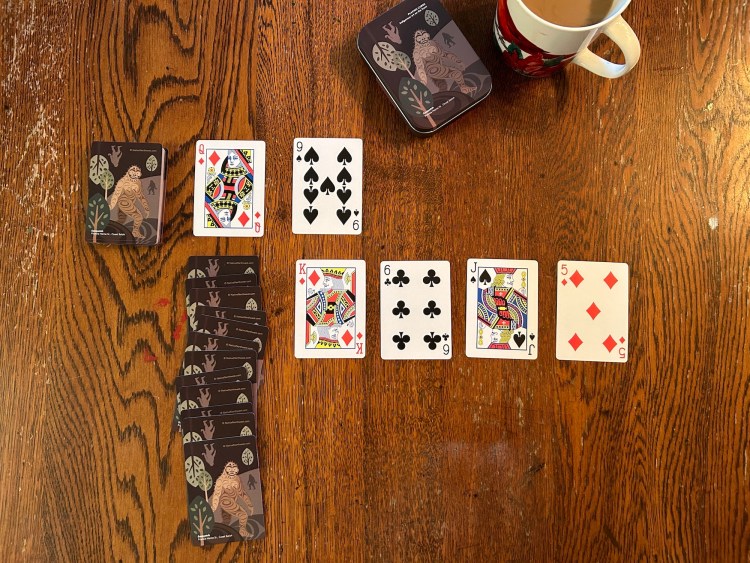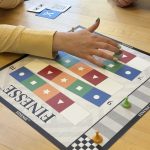Canfield is one of the more challenging versions of solitaire, at one time known as Demon Patience! Here’s what you need to know in order to play.
Mastering Canfield Solitaire: Easy Steps, Fascinating History, and Cool Facts!

Mastering Canfield Solitaire: Easy Steps, Interesting History, and Tips!
Hello, fellow solitaire aficionados and curious minds! Today, we’re going to check out the intriguing world of Canfield Solitaire. Whether you’re a seasoned solitaire expert or just beginning to explore these challenging games, this guide is your ace in the hole. So, let’s shuffle up some knowledge and dig into the details!
When it comes to playing cards, solitaire is a game for one person. There are many versions of solitaire and all involve dealing the cards to a tableau, foundation, and other piles then moving them around according to suits and sequences. I grew up playing solitaire, taught by my dad who learned it during WW2 where he served on a naval ship. A deck of cards ready for a game was always in my purse or bag, but with the advent of smart phones, I now play solitaire on my device.
A Bit of History
Canfield Solitaire has intrigued players for over a century. Originating in England in 1891, it was first known as Demon Patience, a title reflecting its challenging nature. Mary Whitmore Jones, an English writer, hailed it as the finest one-pack card game ever devised, notorious for its ability to tantalizingly snatch victory away at the last moment. This intriguing game caught the attention of Henrietta Stannard, who referenced it in her 1895 novel, illustrating its ability to perennially engage and challenge players.
Demon Patience crossed the Atlantic to the United States, where it was initially muddled with Klondike, another solitaire game, in the 1907 Hoyle’s Games book. The distinct gambling version described there involved buying a deck of cards for $52 and earning $5 for every card played to the foundations. The game’s transformation into Canfield Solitaire is intertwined with the notorious gambler Richard A. Canfield. In 1894, Canfield took over the Clubhouse in Saratoga Springs, New York, and after 1900, he encouraged gamblers at his casino to “buy” a deck of cards. Players could potentially win a substantial sum if they were skillful (or lucky) enough to place all 52 cards into the foundations. However, this version of the game never gained widespread popularity in the gambling community, largely due to its longer duration compared to other casino games and the necessity of employing a croupier for each player.
Today, Canfield Solitaire remains a testament to its complex and engaging history, continuing to challenge and fascinate players around the world. The game’s popularity has surged with the rise of computers, as it became a staple in many solitaire collections. You can give it a go and play Canfield online at Solitaire Bliss.
My father used to play solitaire at home pretending he’d bought the deck and working out his wins and losses – I found this fascinating as a child!
How to Play
Preparing the Deck
To set up Canfield Solitaire, you need a standard deck of 52 cards. Here’s how you get the game on the table:
- Shuffling Up: Mix those cards well! A well-shuffled deck ensures a fair and unpredictable game. We’ve got a great article on how to shuffle here.
- Building the Reserve: Deal out 13 cards in a pile. These cards form a reserve called the “demon”, the top card of which is available for play.
- Beginning the Foundation: Deal one card to start the first of four foundation piles to the right of the reserve. This card sets the rank for the bases of the other three foundations, which must begin with cards of the same rank.
- Begin the Tableau: One card is dealt to each of four piles which form a row under the foundations. This is the tableau.
- The Remaining Deck: Hold onto the rest of the deck; this will be stock.
Gameplay Objectives
Your mission in Canfield Solitaire is to build four complete foundation piles. They start with the rank of the first card flipped from the stockpile and continue in ascending order. Aces follow Kings to keep the game rolling.
The Play:
- Tableau Tactics: You can move cards between tableau piles, but they must alternate in colour and descend in order.
- Empty Space Strategies: An empty tableau spot? That’s your chance to start a new sequence with any card. Some games of solitaire require a King to fill an empty space, but in Canfield it can be any ard.
- Drawing from the Deck: Keep turning over cards from your hand, strategizing their placement in the tableau or foundations.
- The Endgame: The game wraps up when you either have no moves left or when you’ve successfully played all cards into the foundation piles.
In the tableau, arrange cards in descending order and alternating colors, looping from Ace to King as necessary. The foundations, on the other hand, are built up in suit sequence, also wrapping from King to Ace if needed.
When dealing from the stock, do so in packets of three, placing them face up on a waste pile. After each packet is dealt, play the top card of the waste pile to a foundation or tableau, following the game’s rules. Within the tableau, you can move cards either individually or as complete sequences, ensuring the entire column is moved.
The Reserve serves as an additional resource for the player to make moves. The top card of the Reserve can be used to build onto the foundations or onto the tableau piles. The Reserve plays a crucial role in the game, as it offers more options and strategies for completing the foundations or rearranging the tableau. As cards from the Reserve are used, new top cards become available, continuously providing fresh opportunities for play.
When the Reserve is used up, it creates an empty space that can then be filled with a card from the waste pile. This allows for more strategic moves as the game progresses and one of the things that makes Canfield not only unique in the world of Solitaire but also most challenging. If there are no cards in the waste pile to fill the empty space in the Reserve, this space remains empty until a suitable card becomes available.
Managing the Reserve effectively is a key part of the strategy in Canfield Solitaire, as it can greatly influence the flow and outcome of the game.
When your stock pile is used up, you can flip it over (but do not shuffle) and start dealing again in packets of three. You’re allowed unlimited re-deals as long as there are available moves, although Richard Canfield himself limited the number of times gamblers could re-deal the stock in his casino. The game my father played, you could only go through the stockpile once.
Strategies & Tips
- Strategic Reserve Use: Always prioritize using the top card of the Reserve to fill gaps in the tableau or build foundations, as it provides more options.
- Foundation Focus: Begin building foundations early, starting with the initial foundation card’s rank. Consistently add to them as opportunities arise.
- Tableau Management: Arrange cards in the tableau in descending order and alternating colors. This organization is key for revealing new cards and creating playable sequences.
- Waste Pile Utilization: After dealing three cards to the waste pile, actively look to use the top card for building the tableau or foundations. This keeps your options open and reduces waste pile size.
- Filling the Reserve: When the Reserve is depleted, refill it from the waste pile if possible, maintaining an additional source for playable cards.
- Ace and King Strategy: Be mindful of Aces and Kings. Since you can loop from Ace to King (and vice versa) in the tableau, these cards can be pivotal in creating new sequences.
- Sequence Movement: Remember that you can move entire sequences in the tableau, not just individual cards. Use this to uncover hidden cards and create new opportunities.
- Stock Re-dealing: Use the unlimited re-deals of the stock to your advantage. This can open up new plays, especially when you’re stuck.
- Predictive Play: Anticipate potential sequences and moves. Planning a few steps ahead can prevent situations where you are unable to make a move.
- Balancing Acts: Keep a balance between focusing on the tableau and the foundations. Overemphasis on one area can limit your options and hinder progress in the game.
And there you have it, your comprehensive guide to mastering Canfield Solitaire. With a blend of strategy, foresight, and a dash of luck, you’re well on your way to becoming a Canfield connoisseur. So, pick up a deck and let the cards fall where they may!








